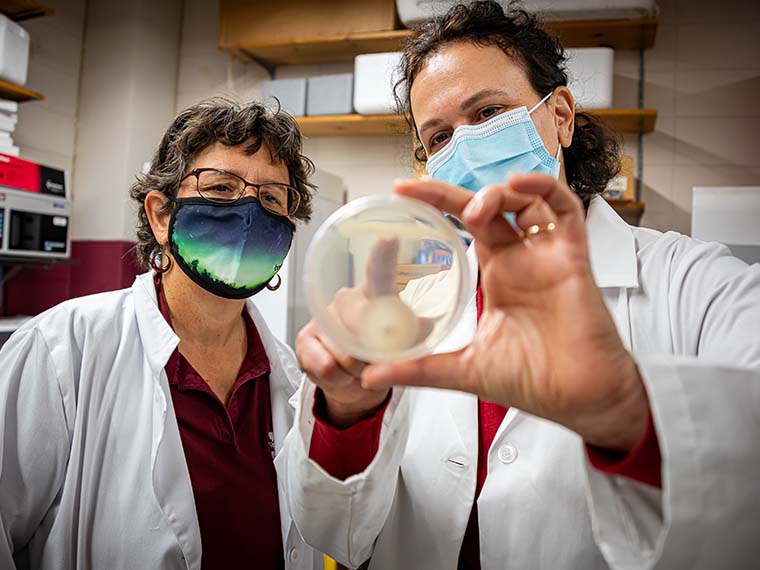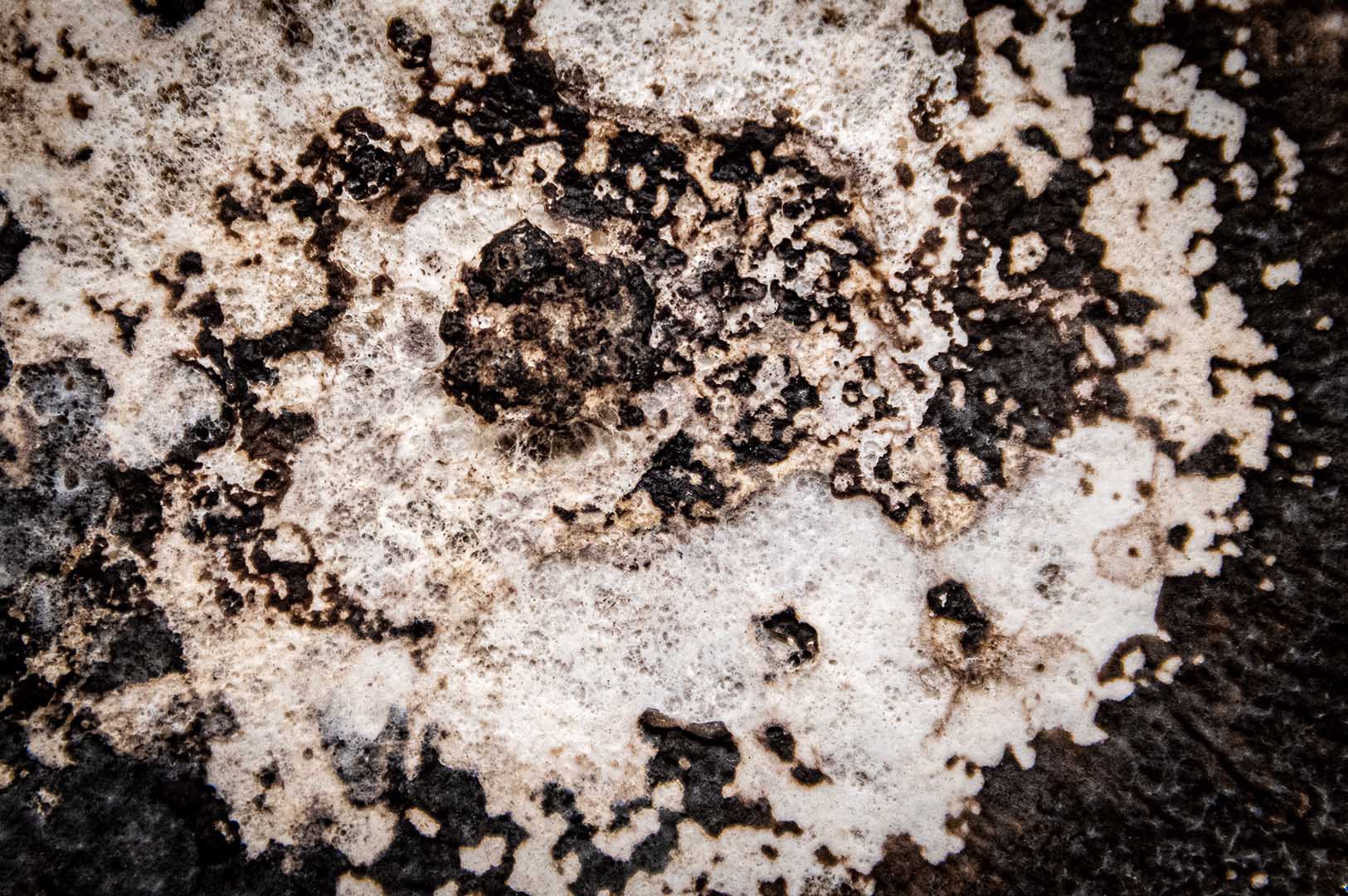The information presented on this page may be dated. It may refer to situations which have changed or people who are no longer affiliated with the university. It is archived as part of Mississippi State University's history.
FOR MISSISSIPPIANS, the state's 1.6 million acres of soybeans represented a $762 million production value in 2019, positioning our state as the thirteenth top soybean producer in the nation. However, within the soybean fields, this prosperity is being threatened by a novel pathogen known as Xylaria.
Xylaria sp. is a fungal species that occasionally emerges into knobby, black structures known as "dead man's fingers" that help the fungus spread and over-winter in the field and is unique to its genus in that it is pathogenic to living plants only. Commonly found in soybean fields, Xylaria sp. has proven to be the leading cause of taproot decline throughout the Southeast, which stands as the seventh-most devastating disease in Mississippi soybean production systems.
Dr. Teresa Wilkerson, assistant research professor at the Delta Research and Extension Center (DREC) has witnessed the effects of this fungus firsthand since it first emerged in soybean fields six years ago.
"I was working towards my Ph.D. under Drs. Tom Allen and Maria Tomaso-Peterson when the disease first emerged. We were consistently seeing interveinal chlorosis, which essentially means leaf yellowing, a typical characteristic of an infected soybean plant," Wilkerson explained. "It can be tricky though, since several soybean diseases produce very similar symptoms on the leaves. Being this is a root disease, the only real way to know for sure is to pull it up and examine the root system. If it has been infected, then the taproot will be so brittle that it breaks right off, and of course, without the root system healthy and intact, a plant can't survive."
Because only a handful of years have passed since Xylaria sp. has been identified as the pathogen causing taproot decline, most of the research conducted thus far has been focused on understanding how the fungus works as well as how to test various soybean cultivars for resistance.
Wilkerson has participated in some of this preliminary research and shared how the cultivars hold up against Xylaria.
"There are, in fact, some varieties of soybean that seem to have less susceptibility to taproot decline from this fungus, but the trade-off for resistance is yield. The resistant soybean produces less than those more susceptible, creating something of a conundrum for producers. If Xylaria sp. hasn't spread to their fields yet, producers are going to plant the variety that will give them a higher yield, even if that means sacrificing resistance, which could mean further sacrificing their harvest if the fungus does appear," Wilkerson said.
With that in mind, MAFES researchers have pivoted their focus from identifying the cause of taproot decline to understanding the immune response of Xylaria-infected soybean. Researchers Wilkerson, Tomaso-Peterson, and Dr. Sorina Popescu began by tracking the genetic pathways activated by infected plants fighting off the disease.
With a good understanding of the soybean's immune response to Xylaria sp. at the molecular level, the team began searching for ways to supplement this response through a biological control, which mitigates pests and pathogens through natural enemies.
Dr. Sorina Popescu, associate professor in the Department of Biochemistry, Molecular Biology, Entomology and Plant Pathology, and an accomplished plant immunologist, joined the study with a particular interest in the microbiology of the soil. Popescu shared the often-overlooked defensive possibilities of a curated microbiome.
"Microbial composition of the soil has a profound impact on the health of growing plants. Some may help the plant thrive in environmental conditions that aren't necessarily the environment where they normally flourish, and some directly act on pathogenic microbes by inhibiting the growth of that pathogen, meaning it doesn't have a chance to spread and infect massive stretches of production fields," Popescu explained.
The MAFES researchers have been testing the microbiome of healthy sites and comparing it to unhealthy sites. In addition to gathering this field data, they are testing the effects of more than 300 bacterial strains on soybean seed grown in the lab and growth chambers. Of the number tested so far, approximately 15 bacterial strains inhibit Xylaria sp. growth both in the lab and in the growth chamber.
Popescu explained how microbial seed treatment benefits soybean plants.
"When we treat the seed with these beneficial bacteria, the plants look completely healthy in the presence of Xylaria sp; we do not detect any of the disease's characteristic symptoms on the plants' foliage or roots. A microbial seed treatment, once properly tested, would not only have the anti-Xylaria effects needed by soybean producers, but it would also serve as a more practical and more environmentally-friendly alternative to traditional fungicides," Popescu said.
Fundamental to the research, Dr. Tomaso-Peterson, a research professor in the Department of Biochemistry, Molecular Biology, Entomology and Plant Pathology, was among the first researchers to identify and study the fungus, primarily by way of characterizing Xylaria sp. and its disease cycle. Given that the next step in the study will be testing the selected microbes at the Delta Research and Extension Center, Tomaso-Peterson shared how this research has come full circle.
"Going from my very fundamental-level work of characterizing the fungus and plant immunity, and then on to Dr. Popescu's work with the basics of the microbiome, and now to Dr. Wilkerson at DREC with directly-applied research, it shows how far we've come in the six years since we first detected taproot decline of soybean in Mississippi fields," Tomaso-Peterson said.
Not only has the team come far in their knowledge of the disease, but they've also got plans to integrate advanced technology into their toolbox. Once the soybeans are in the field at DREC, Tomaso-Peterson shared that they will begin monitoring the fungus through precision agriculture and multispectral analyses.
"One piece of technology that may be considered in future research is drones equipped with multispectral sensor cameras. If Xylaria sp. infects a plant's root, the plant's foliage does not reflect light properly, and the multispectral imaging captures the change in reflection, even if our eyes don't. This way, we'll be able to monitor both the advance of the fungus and the effectiveness of our microbe treatment directly in the field," Tomaso-Peterson said.
Eventually, the team hopes to produce a microbial seed treatment that will allow susceptible, high-yielding soybean cultivars to fight off the fungal infection and remain lucrative for soybean farmers across the Southeast.
This research was funded by the Mississippi Soybean Promotion Board, the Mississippi Agricultural and Forestry Experiment Station, and the Office of Research and Economic Development at Mississippi State University.
There are, in fact, some varieties of soybean that seem to have less susceptibility to taproot decline from this fungus, but the trade-off for resistance is yield.
Dr. Teresa Wilkerson


